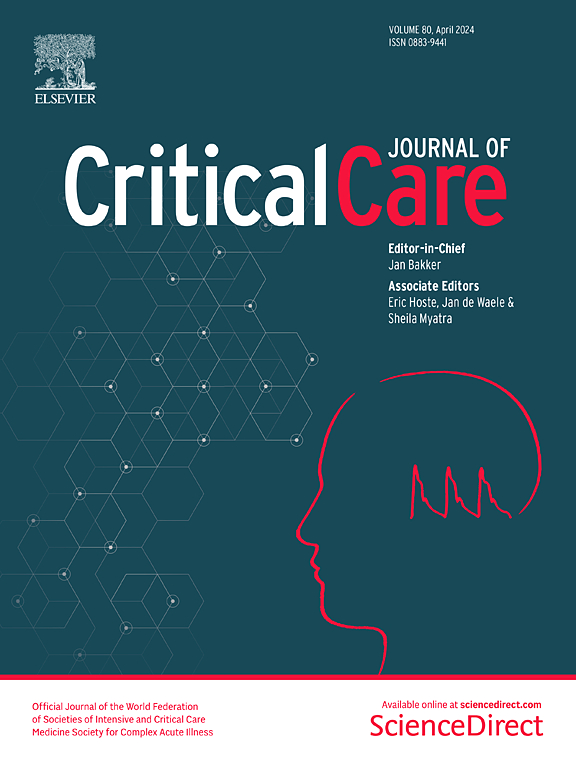Peri-intubation complications in critically ill obese patients: a secondary analysis of the international INTUBE cohort
IF 8.8
1区 医学
Q1 CRITICAL CARE MEDICINE
引用次数: 0
Abstract
Airway management in critically ill obese patients is potentially associated with a higher risk of adverse events due to a constellation of physiological and anatomical challenges. Data from international prospective studies on peri-intubation adverse events in obese critically ill patients are lacking. INTUBE (International Observational Study to Understand the Impact and Best Practices of Airway Management In Critically Ill Patients) was an international multicentre prospective cohort study enrolling critically ill adult patients undergoing in-hospital tracheal intubation in 197 sites from 29 countries worldwide from October 1, 2018, to July 31, 2019. This secondary analysis compares airway management practices and outcomes between obese (body mass index–BMI $$\ge$$ 30 kg/m2) and non-obese patients (BMI $$<$$ 30 kg/m2). A total of 2946 patients met inclusion criteria for this secondary analysis, 639 (21.7%) obese and 2307 (78.3%) non-obese. Severe peri-intubation hypoxemia was more frequently reported in obese compared to non-obese patients (12.1% vs 8.6% respectively, p = 0.01). Variables independently associated with a higher risk of peri-intubation hypoxemia were baseline SpO2/FiO2 (OR 0.996, 95% CI 0.994–0.997), 30–45° head-up position (OR 1.53, 95% CI 1.04–2.26) and first-pass intubation failure (OR for first-pass success 0.21, 95% CI 0.15–0.29). Obesity (OR 0.71, 95% CI 0.56–0.91) and 20° head-up position (OR 0.67, 95% CI 0.47–0.95) were independently associated with higher likelihood of first-pass intubation failure. In contrast, intubation by staff physician/consultant (OR 1.70, 95% CI 1.30–2.21) or anesthesiologists (OR 1.98, 95% CI 1.55–2.53) were associated with higher first-pass success. Compared to non-obese patients, obese critically ill exhibit a higher incidence of peri-intubation severe hypoxemia. In this population, worse baseline oxygenation and first-pass intubation failure significantly increase the risk of peri-intubation severe hypoxemia. As obesity is linked to a higher likelihood of first-pass intubation failure, likely driven by more challenging airway features, in this high-risk population first attempt should be performed by an expert operator to minimize peri-intubation complications. Trial registration: Clinicaltrials.gov NCT03616054 . Registered 3 August 2018.危重肥胖患者的围插管并发症:国际INTUBE队列的二次分析
由于一系列生理和解剖学上的挑战,危重肥胖患者的气道管理可能与较高的不良事件风险相关。缺乏关于肥胖危重患者插管期不良事件的国际前瞻性研究数据。INTUBE(了解危重患者气道管理影响和最佳实践的国际观察性研究)是一项国际多中心前瞻性队列研究,于2018年10月1日至2019年7月31日在全球29个国家的197个地点招募了住院气管插管的危重成人患者。这项二级分析比较了肥胖(体重指数- BMI $$\ge$$ 30 kg/m2)和非肥胖(BMI $$<$$ 30 kg/m2)患者的气道管理方法和结果。共有2946例患者符合该次要分析的纳入标准,639例(21.7例)%) obese and 2307 (78.3%) non-obese. Severe peri-intubation hypoxemia was more frequently reported in obese compared to non-obese patients (12.1% vs 8.6% respectively, p = 0.01). Variables independently associated with a higher risk of peri-intubation hypoxemia were baseline SpO2/FiO2 (OR 0.996, 95% CI 0.994–0.997), 30–45° head-up position (OR 1.53, 95% CI 1.04–2.26) and first-pass intubation failure (OR for first-pass success 0.21, 95% CI 0.15–0.29). Obesity (OR 0.71, 95% CI 0.56–0.91) and 20° head-up position (OR 0.67, 95% CI 0.47–0.95) were independently associated with higher likelihood of first-pass intubation failure. In contrast, intubation by staff physician/consultant (OR 1.70, 95% CI 1.30–2.21) or anesthesiologists (OR 1.98, 95% CI 1.55–2.53) were associated with higher first-pass success. Compared to non-obese patients, obese critically ill exhibit a higher incidence of peri-intubation severe hypoxemia. In this population, worse baseline oxygenation and first-pass intubation failure significantly increase the risk of peri-intubation severe hypoxemia. As obesity is linked to a higher likelihood of first-pass intubation failure, likely driven by more challenging airway features, in this high-risk population first attempt should be performed by an expert operator to minimize peri-intubation complications. Trial registration: Clinicaltrials.gov NCT03616054 . Registered 3 August 2018.
本文章由计算机程序翻译,如有差异,请以英文原文为准。
求助全文
约1分钟内获得全文
求助全文
来源期刊

Critical Care
医学-危重病医学
CiteScore
20.60
自引率
3.30%
发文量
348
审稿时长
1.5 months
期刊介绍:
Critical Care is an esteemed international medical journal that undergoes a rigorous peer-review process to maintain its high quality standards. Its primary objective is to enhance the healthcare services offered to critically ill patients. To achieve this, the journal focuses on gathering, exchanging, disseminating, and endorsing evidence-based information that is highly relevant to intensivists. By doing so, Critical Care seeks to provide a thorough and inclusive examination of the intensive care field.
 求助内容:
求助内容: 应助结果提醒方式:
应助结果提醒方式:


